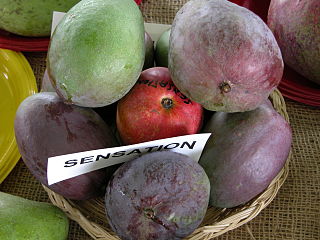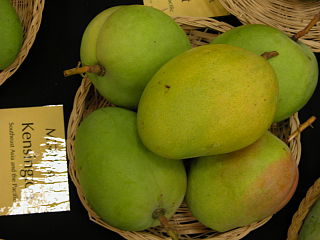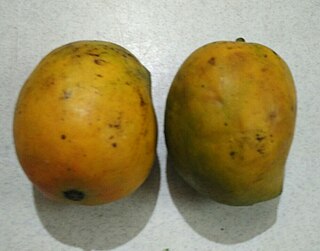
A mango is an edible stone fruit produced by the tropical tree Mangifera indica. It is believed to have originated between northwestern Myanmar, Bangladesh, and northeastern India. M. indica has been cultivated in South and Southeast Asia since ancient times resulting in two types of modern mango cultivars: the "Indian type" and the "Southeast Asian type". Other species in the genus Mangifera also produce edible fruits that are also called "mangoes", the majority of which are found in the Malesian ecoregion.

Lychee is a monotypic taxon and the sole member in the genus Litchi in the soapberry family, Sapindaceae.

Cucumber is a widely-cultivated creeping vine plant in the Cucurbitaceae family that bears usually cylindrical fruits, which are used as culinary vegetables. Considered an annual plant, there are three main varieties of cucumber—slicing, pickling, and seedless—within which several cultivars have been created. The cucumber originates from South Asia, but now grows on most continents, as many different types of cucumber are traded on the global market. In North America, the term wild cucumber refers to plants in the genera Echinocystis and Marah, though the two are not closely related.

Guava is a common tropical fruit cultivated in many tropical and subtropical regions. The common guava Psidium guajava is a small tree in the myrtle family (Myrtaceae), native to Mexico, Central America, the Caribbean and northern South America. The name guava is also given to some other species in the genus Psidium such as strawberry guava and to the pineapple guava, Feijoa sellowiana. In 2019, 55 million tonnes of guavas were produced worldwide, led by India with 45% of the total. Botanically, guavas are berries.

An orange is a fruit of various citrus species in the family Rutaceae ; it primarily refers to Citrus × sinensis, which is also called sweet orange, to distinguish it from the related Citrus × aurantium, referred to as bitter orange. The sweet orange reproduces asexually ; varieties of sweet orange arise through mutations.

Diospyros kaki, the Oriental persimmon, Chinese persimmon, Japanese persimmon or kaki persimmon, is the most widely cultivated species of the genus Diospyros. Although its first botanical description was not published until 1780, D. kaki is among the oldest cultivated plants, having been in use in China for more than 2000 years.

Banganapalle mangoes is a mango variety produced in Banganapalle of Nandyal District in the Indian state of Andhra Pradesh. It alone occupies 70% percent of total mango cultivable area of the state and was first introduced by the Farmers of Banaganapalli. It was registered as one of the geographical indication from Andhra Pradesh on 3 May 2017, under horticultural products by Geographical Indication Registry. It is also grown in the other parts of India and Pakistan. The fruit is described as obliquely oval in shape, around 20cm in length, with yellow flesh and a thin, smooth yellow skin. The flesh is of a firm, meaty texture and is sweet and lacks fibre. The cultivar is the most sought after in Andhra Pradesh. It is a very late -season variety that is good for canning. This cultivar is a source of vitamin A & C and is also called king of Mangoes.

The 'Edward' mango is a named mango cultivar that originated in south Florida.

The 'Alampur Beneshan' mango, sometimes spelled Banishan, is a named mango cultivar that originates from India. In southern India, it is sometimes known as Seeri. It differs from, but is related ancestrally to, the high-volume commercial cultivar Banganapalli. However, this is a much older and prized cultivar.

The 'Mallika' mango is the result of the hybridization of the Indian mango varieties Neelum and Dasheri. The variety was introduced by Dr. Ramnath Singh. When grafted, the tree will remain a manageable size and is appropriate for dooryard growing. Fruit is normally ready to harvest from June to July.

The 'Sensation' mango is a late-season mango cultivar that originated in south Florida and was grown on a commercial scale.

The 'Springfels' mango is a large, commercially grown mango cultivar that originated in south Florida.

The 'Brooks' mango is a late-season commercial mango cultivar that originated in south Florida. It is a parent of several varieties from the state.

The 'Hatcher' mango is a named commercial mango cultivar that originated in south Florida.

The 'Kensington Pride' mango is a named commercial mango cultivar that originated in Australia. It is sometimes called the KP, Bowen or Bowen special. It is Australia's most popular mango, accounting for over 80% of the country's annual commercial mango market. It is considered to have a distinctive flavour and aroma when compared with the Florida-bred cultivars grown by most mango-exporting countries.

The 'Parvin' mango is a named commercial mango cultivar that originated in Southwest Florida.

Malgova' or Malgoa is an important mango cultivar mainly grown in Tamilnadu and Karnataka and also in other parts of South India. It is a large round fruit, it has a small hard seed inside and is very juicy and fragrant. It is generally considered to be one of the best mangoes. Its production area is centred on the districts of Salem, Dharmapuri and Krishnagiri in Tamil Nadu, Gujarat, as well as neighbouring parts of Andhra Pradesh and Karnataka.

The 'Valencia Pride' mango is a named late-season mango cultivar that originated in south Florida.

The 'Raspuri' mango is an extremely popular variety of mango in South Indian state of Karnataka especially grown in and around Bengaluru, Ramanagara, Kolar, Chikkaballapura, Tumakuru. This fruit is also known as sweet mango. It is also known as the Pairi mango in Maharashtra state.




















